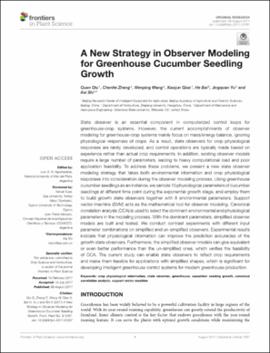| dc.contributor.author | Qiu, Quan | |
| dc.contributor.author | Zheng, Chenfei | |
| dc.contributor.author | Wang, Wenping | |
| dc.contributor.author | Qiao, Xiaojun | |
| dc.contributor.author | Bai, He | |
| dc.contributor.author | Yu, Jingquan | |
| dc.contributor.author | Shi, Kai | |
| dc.date.accessioned | 2019-09-25T18:24:40Z | |
| dc.date.available | 2019-09-25T18:24:40Z | |
| dc.date.issued | 2017-08-08 | |
| dc.identifier | oksd_qiu_anewstrategyino_2017 | |
| dc.identifier.citation | Qiu, Q., Zheng, C., Wang, W., Qiao, X., Bai, H., Yu, J., & Shi, K. (2017). A new strategy in observer modeling for greenhouse cucumber seedling growth. Frontiers in Plant Science, 8, Article 1297. https://doi.org/10.3389/fpls.2017.01297 | |
| dc.identifier.uri | https://hdl.handle.net/11244/321432 | |
| dc.description.abstract | State observer is an essential component in computerized control loops for greenhouse-crop systems. However, the current accomplishments of observer modeling for greenhouse-crop systems mainly focus on mass/energy balance, ignoring physiological responses of crops. As a result, state observers for crop physiological responses are rarely developed, and control operations are typically made based on experience rather than actual crop requirements. In addition, existing observer models require a large number of parameters, leading to heavy computational load and poor application feasibility. To address these problems, we present a new state observer modeling strategy that takes both environmental information and crop physiological responses into consideration during the observer modeling process. Using greenhouse cucumber seedlings as an instance, we sample 10 physiological parameters of cucumber seedlings at different time point during the exponential growth stage, and employ them to build growth state observers together with 8 environmental parameters. Support vector machine (SVM) acts as the mathematical tool for observer modeling. Canonical correlation analysis (CCA) is used to select the dominant environmental and physiological parameters in the modeling process. With the dominant parameters, simplified observer models are built and tested. We conduct contrast experiments with different input parameter combinations on simplified and un-simplified observers. Experimental results indicate that physiological information can improve the prediction accuracies of the growth state observers. Furthermore, the simplified observer models can give equivalent or even better performance than the un-simplified ones, which verifies the feasibility of CCA. The current study can enable state observers to reflect crop requirements and make them feasible for applications with simplified shapes, which is significant for developing intelligent greenhouse control systems for modern greenhouse production. | |
| dc.format | application/pdf | |
| dc.language | en_US | |
| dc.publisher | Frontiers Media | |
| dc.rights | This material has been previously published. In the Oklahoma State University Library's institutional repository this version is made available through the open access principles and the terms of agreement/consent between the author(s) and the publisher. The permission policy on the use, reproduction or distribution of the material falls under fair use for educational, scholarship, and research purposes. Contact Digital Resources and Discovery Services at lib-dls@okstate.edu or 405-744-9161 for further information. | |
| dc.title | New strategy in observer modeling for greenhouse cucumber seedling growth | |
| osu.filename | oksd_qiu_anewstrategyino_2017.pdf | |
| dc.description.peerreview | Peer reviewed | |
| dc.identifier.doi | 10.3389/fpls.2017.01297 | |
| dc.description.department | Mechanical and Aerospace Engineering | |
| dc.type.genre | Article | |
| dc.type.material | Text | |
| dc.subject.keywords | crop physiological information | |
| dc.subject.keywords | state observer | |
| dc.subject.keywords | greenhouse | |
| dc.subject.keywords | cucumber seedling growth | |
| dc.subject.keywords | canonical correlation analysis | |
| dc.subject.keywords | support vector machine | |
